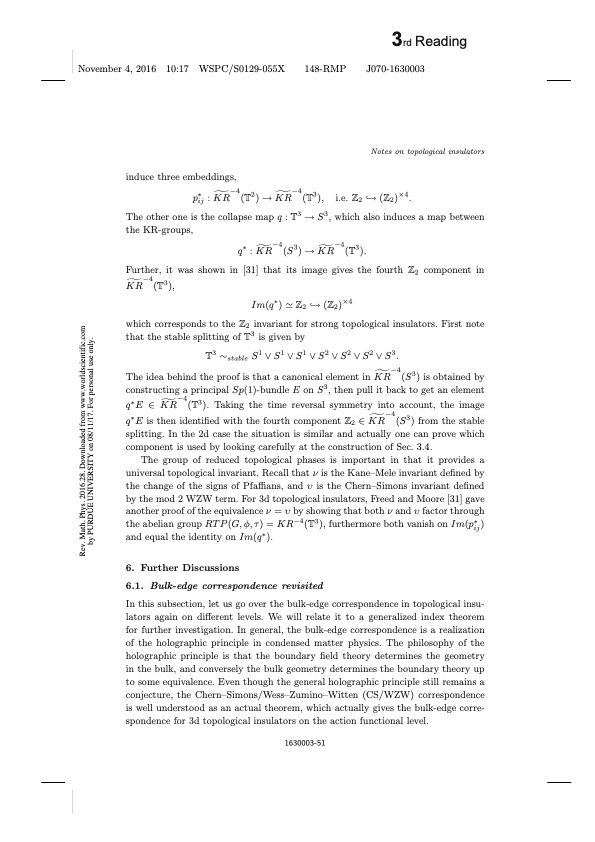
PDF Publication Title:
Text from PDF Page: 051
induce three embeddings, ∗ −4 2 −4 3 ×4 pij :KR (T )→KR (T ), i.e.Z2 →(Z2) . The other one is the collapse map q : T3 → S3, which also induces a map between the KR-groups, ∗ −4 3 −4 3 q:KR (S)→KR (T). Further, it was shown in [31] that its image gives the fourth Z2 component in −4 3 KR (T), which corresponds to the Z2 invariant for strong topological insulators. First note Im(q∗) ≃ Z2 → (Z2)×4 that the stable splitting of T3 is given by T3 ∼stable S1 ∨S1 ∨S1 ∨S2 ∨S2 ∨S2 ∨S3. −4 3 The idea behind the proof is that a canonical element in KR (S ) is obtained by constructing a principal Sp(1)-bundle E on S3, then pull it back to get an element ∗ −43 q E ∈ KR (T ). Taking the time reversal symmetry into account, the image ∗ −4 3 q E is then identified with the fourth component Z2 ∈ KR (S ) from the stable splitting. In the 2d case the situation is similar and actually one can prove which component is used by looking carefully at the construction of Sec. 3.4. The group of reduced topological phases is important in that it provides a universal topological invariant. Recall that ν is the Kane–Mele invariant defined by the change of the signs of Pfaffians, and υ is the Chern–Simons invariant defined by the mod 2 WZW term. For 3d topological insulators, Freed and Moore [31] gave another proof of the equivalence ν = υ by showing that both ν and υ factor through the abelian group RTP(G,φ,τ) = KR−4(T3), furthermore both vanish on Im(p∗ij) and equal the identity on Im(q∗). 6. Further Discussions 6.1. Bulk-edge correspondence revisited In this subsection, let us go over the bulk-edge correspondence in topological insu- lators again on different levels. We will relate it to a generalized index theorem for further investigation. In general, the bulk-edge correspondence is a realization of the holographic principle in condensed matter physics. The philosophy of the holographic principle is that the boundary field theory determines the geometry in the bulk, and conversely the bulk geometry determines the boundary theory up to some equivalence. Even though the general holographic principle still remains a conjecture, the Chern–Simons/Wess–Zumino–Witten (CS/WZW) correspondence is well understood as an actual theorem, which actually gives the bulk-edge corre- spondence for 3d topological insulators on the action functional level. 1630003-51 Notes on topological insulators Rev. Math. Phys. 2016.28. Downloaded from www.worldscientific.com by PURDUE UNIVERSITY on 08/11/17. For personal use only.PDF Image | Notes on topological insulators

PDF Search Title:
Notes on topological insulatorsOriginal File Name Searched:
RMP.pdfDIY PDF Search: Google It | Yahoo | Bing
Sulfur Deposition on Carbon Nanofibers using Supercritical CO2 Sulfur Deposition on Carbon Nanofibers using Supercritical CO2. Gamma sulfur also known as mother of pearl sulfur and nacreous sulfur... More Info
CO2 Organic Rankine Cycle Experimenter Platform The supercritical CO2 phase change system is both a heat pump and organic rankine cycle which can be used for those purposes and as a supercritical extractor for advanced subcritical and supercritical extraction technology. Uses include producing nanoparticles, precious metal CO2 extraction, lithium battery recycling, and other applications... More Info
| CONTACT TEL: 608-238-6001 Email: greg@infinityturbine.com | RSS | AMP |